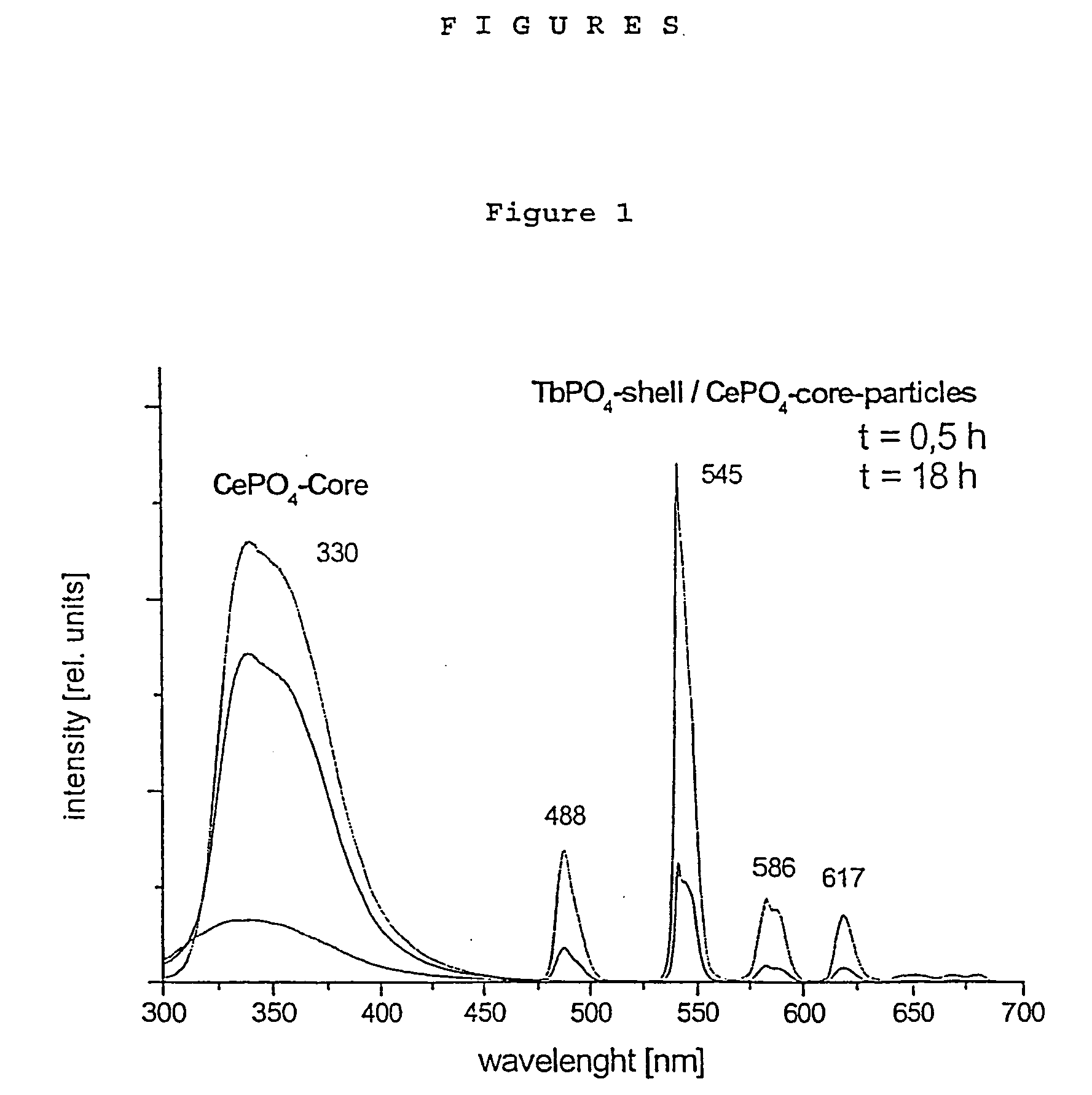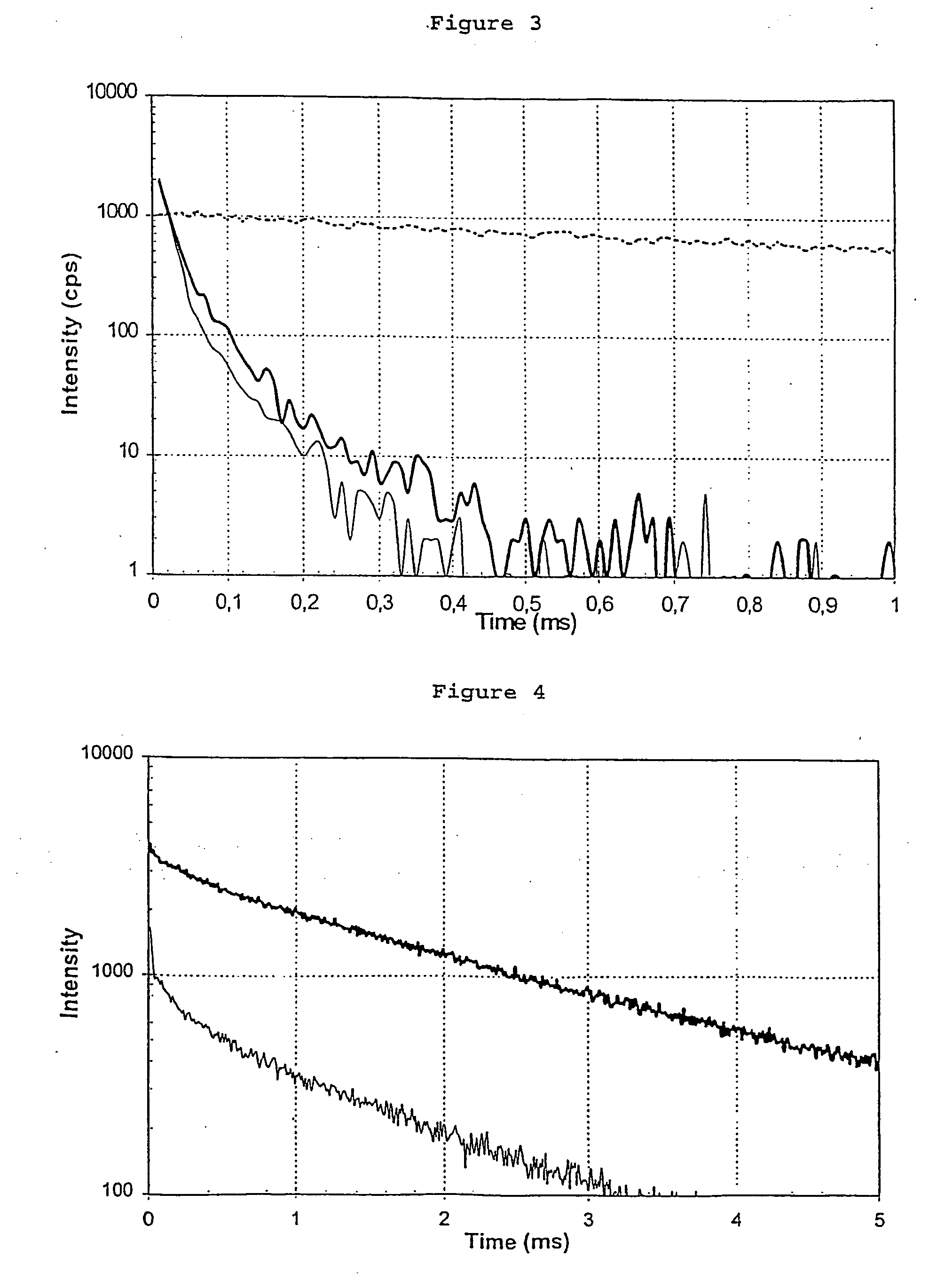Core/shell nanoparticles suitable for(f)ret-assays
a nanoparticle and core technology, applied in the direction of nanotechnology, instruments, coatings, etc., can solve the problems of fluorescent dyes, insufficient stability towards incident light, phototoxicity, etc., and achieve the effect of reducing the number of nanoparticles and reducing the number of cores
- Summary
- Abstract
- Description
- Claims
- Application Information
AI Technical Summary
Problems solved by technology
Method used
Image
Examples
example 1
CePO4 Nanoparticle Cores having a TbPO4 Shell
[0292] In a 100 ml round-bottom flask provided with a high performance reflux condenser, a temperature probe and heating mantel, 3,72 g (10 mmol) CeCl3×7H2O are dissolved in about 4 ml methanol followed by adding 40 ml tris-2-ethylhexylphosphat (TEHP) to the resulting solution. A vacuum is applied to the round-bottom flask in order to remove methanol and crystallization water, firstly at room temperature (1 to 2 hours) and then at 50° C. (about 1,5 hours).
[0293] In a second flask, dry ortho-phosphoric acid (20 mmol) is dissolved in 5 ml tetraethyleneglycoldimethylether.
[0294] Under a nitrogen atmosphere and at 50° C., 13,1 ml (30,0 mmol) trioctylamine and 2.5 ml ortho-phosphoric acid / tetraethyleneglycol dimethylether mixture are added to the CeCl3 solution in TEHP. Thereafter the mixture is heated 15 hours to 200° C. After this period of time, a clear dispersion (“first mixture”) of CePO4 particles (average diameter 5 btained.
[0295] a...
example 2
LaPO4 Nanoparticle Cores having a TbPO4 Shell
[0300] In a 100 ml round-bottom flask provided with a high performance reflux condenser, a temperature probe and heating mantel, 3,2 g (8,6 mmol) LaCl3×7H2O are dissolved in about 10 ml methanol followed by adding 39 ml tris-2-ethylhexylphosphat (TEHP) to the resulting solution. A vacuum is applied to the round-bottom flask in order to remove methanol and crystallization water, firstly at room temperature (1 to 2 hours) and then at 50° C. (several hours).
[0301] In a second flask, dry ortho-phosphoric acid (20 mmol) is dissolved in 5 ml tetraethyleneglycol dimethylether.
[0302] Under a nitrogen atmosphere and at 50° C., 11,5 ml (26,3 mmol) trioctylamine and 2.3 ml ortho-phosphoric acid / tetra-ethyleneglycol dimethylether mixture are added to the LaCl3 solution in TEHP. Thereafter the mixture is heated 16 hours to 200° C. After this period of time, a clear dispersion (“first mixture”) of LaPO4 particles is obtained.
[0303] In a second 100 ...
reference example 1
Analysis of Core / Shell Particle
[0304] The following reference example describes the measurement of chemical composition, core diameter and shell thickness of CePO4:Tb nanoparticle cores having a LaPO4 shell. Even though these particles are not covered by the claims, this analysis technique is fully applicable to the present invention.
[0305] For this purpose the particles were mounted on carbon film provided with holes and studied under a Philipps CM30OUT microscope.
[0306] EELS (Electron Energy Loss Spectroscopy) showed that the average chemical composition of the cations was Ce / La=0,34 ±0,05, Tb / La=0,12±0,03 which means that La / Ce=3,0 ±0,4 and Ce / Tb=2,8±0,8, the latter value corresponding approximately to the molar ratio CeYTb (3,14 / 1) used.
[0307] HREM (High Resolution Electron microscopy) confirmed the crystallinity of the core / shell particles obtained.
[0308] Moreover, a Hellfeld image was taken with a slight underfocus at a scanning rate of 0,48 nm / image point in order to cov...
PUM
| Property | Measurement | Unit |
|---|---|---|
| Temperature | aaaaa | aaaaa |
| Diameter | aaaaa | aaaaa |
| Thickness | aaaaa | aaaaa |
Abstract
Description
Claims
Application Information
 Login to View More
Login to View More - R&D
- Intellectual Property
- Life Sciences
- Materials
- Tech Scout
- Unparalleled Data Quality
- Higher Quality Content
- 60% Fewer Hallucinations
Browse by: Latest US Patents, China's latest patents, Technical Efficacy Thesaurus, Application Domain, Technology Topic, Popular Technical Reports.
© 2025 PatSnap. All rights reserved.Legal|Privacy policy|Modern Slavery Act Transparency Statement|Sitemap|About US| Contact US: help@patsnap.com



